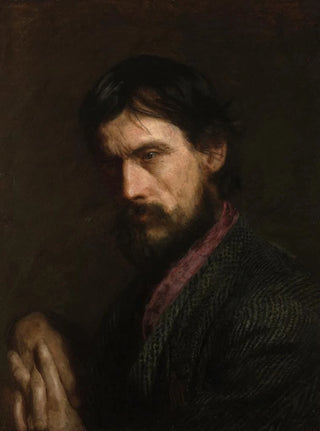Art print | The portrait of veteran George Reynolds - Thomas Eakins


View from behind

Frame (optional)
In the fascinating world of art, some works manage to transcend time and capture the very essence of humanity. "The portrait of veteran George Reynolds" by Thomas Eakins is a quintessential example. This painting, which serves as a vibrant tribute to the bravery and resilience of a man who served his country, evokes a multitude of emotions within us. The depiction of Reynolds, with his penetrating gaze and stoic attitude, invites us to reflect on sacrifice and human dignity. Through this artwork, Eakins encourages us to explore not only the veteran's personal journey but also the historical and social context of his era.
Style and uniqueness of the work
Thomas Eakins' style is distinguished by its striking realism and attention to detail, characteristics that are vividly expressed in this portrait. Every brushstroke seems imbued with a profound intention, revealing the psychology of the subject while celebrating the strength of his character. Light plays a crucial role, highlighting the veteran's features and creating an atmosphere that is both intimate and solemn. The carefully chosen colors add an emotional dimension to the painting, reinforcing the idea that each visual element contributes to the narrative of the work. George Reynolds' posture, both proud and humble, embodies a duality that challenges the viewer, inviting reflection on the notions of heroism and sacrifice.
The artist and his influence
Thomas Eakins, a key figure in 19th-century American art, left a lasting mark on his era with his bold vision and commitment to realism. Trained at the École des Beaux-Arts in Paris, he integrated European techniques while developing a style deeply rooted in American culture. Eakins did not merely reproduce images; he sought to capture the soul of his subjects and explore the complexities of the human condition. His influence is felt not only in painting but also in photography and art education. Through his works, he paved the way for a new understanding of art, where truth and authenticity took center stage.

Matte finish

View from behind

Frame (optional)
In the fascinating world of art, some works manage to transcend time and capture the very essence of humanity. "The portrait of veteran George Reynolds" by Thomas Eakins is a quintessential example. This painting, which serves as a vibrant tribute to the bravery and resilience of a man who served his country, evokes a multitude of emotions within us. The depiction of Reynolds, with his penetrating gaze and stoic attitude, invites us to reflect on sacrifice and human dignity. Through this artwork, Eakins encourages us to explore not only the veteran's personal journey but also the historical and social context of his era.
Style and uniqueness of the work
Thomas Eakins' style is distinguished by its striking realism and attention to detail, characteristics that are vividly expressed in this portrait. Every brushstroke seems imbued with a profound intention, revealing the psychology of the subject while celebrating the strength of his character. Light plays a crucial role, highlighting the veteran's features and creating an atmosphere that is both intimate and solemn. The carefully chosen colors add an emotional dimension to the painting, reinforcing the idea that each visual element contributes to the narrative of the work. George Reynolds' posture, both proud and humble, embodies a duality that challenges the viewer, inviting reflection on the notions of heroism and sacrifice.
The artist and his influence
Thomas Eakins, a key figure in 19th-century American art, left a lasting mark on his era with his bold vision and commitment to realism. Trained at the École des Beaux-Arts in Paris, he integrated European techniques while developing a style deeply rooted in American culture. Eakins did not merely reproduce images; he sought to capture the soul of his subjects and explore the complexities of the human condition. His influence is felt not only in painting but also in photography and art education. Through his works, he paved the way for a new understanding of art, where truth and authenticity took center stage.






